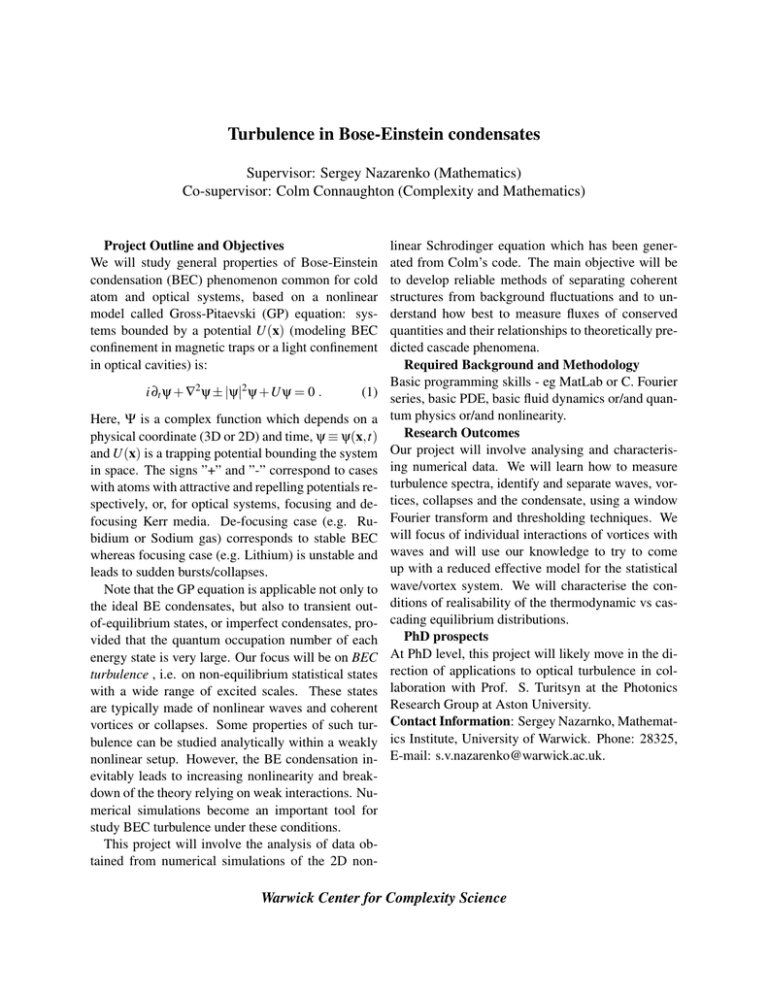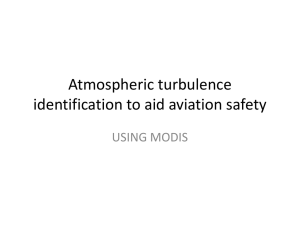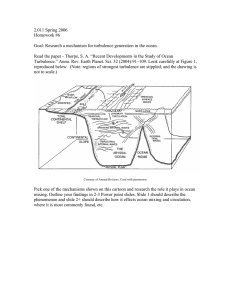Turbulence in Bose-Einstein condensates
advertisement

Turbulence in Bose-Einstein condensates Supervisor: Sergey Nazarenko (Mathematics) Co-supervisor: Colm Connaughton (Complexity and Mathematics) Project Outline and Objectives We will study general properties of Bose-Einstein condensation (BEC) phenomenon common for cold atom and optical systems, based on a nonlinear model called Gross-Pitaevski (GP) equation: systems bounded by a potential U(x) (modeling BEC confinement in magnetic traps or a light confinement in optical cavities) is: i ∂t ψ + ∇2 ψ ± |ψ|2 ψ +Uψ = 0 . (1) Here, Ψ is a complex function which depends on a physical coordinate (3D or 2D) and time, ψ ≡ ψ(x,t) and U(x) is a trapping potential bounding the system in space. The signs ”+” and ”-” correspond to cases with atoms with attractive and repelling potentials respectively, or, for optical systems, focusing and defocusing Kerr media. De-focusing case (e.g. Rubidium or Sodium gas) corresponds to stable BEC whereas focusing case (e.g. Lithium) is unstable and leads to sudden bursts/collapses. Note that the GP equation is applicable not only to the ideal BE condensates, but also to transient outof-equilibrium states, or imperfect condensates, provided that the quantum occupation number of each energy state is very large. Our focus will be on BEC turbulence , i.e. on non-equilibrium statistical states with a wide range of excited scales. These states are typically made of nonlinear waves and coherent vortices or collapses. Some properties of such turbulence can be studied analytically within a weakly nonlinear setup. However, the BE condensation inevitably leads to increasing nonlinearity and breakdown of the theory relying on weak interactions. Numerical simulations become an important tool for study BEC turbulence under these conditions. This project will involve the analysis of data obtained from numerical simulations of the 2D non- linear Schrodinger equation which has been generated from Colm’s code. The main objective will be to develop reliable methods of separating coherent structures from background fluctuations and to understand how best to measure fluxes of conserved quantities and their relationships to theoretically predicted cascade phenomena. Required Background and Methodology Basic programming skills - eg MatLab or C. Fourier series, basic PDE, basic fluid dynamics or/and quantum physics or/and nonlinearity. Research Outcomes Our project will involve analysing and characterising numerical data. We will learn how to measure turbulence spectra, identify and separate waves, vortices, collapses and the condensate, using a window Fourier transform and thresholding techniques. We will focus of individual interactions of vortices with waves and will use our knowledge to try to come up with a reduced effective model for the statistical wave/vortex system. We will characterise the conditions of realisability of the thermodynamic vs cascading equilibrium distributions. PhD prospects At PhD level, this project will likely move in the direction of applications to optical turbulence in collaboration with Prof. S. Turitsyn at the Photonics Research Group at Aston University. Contact Information: Sergey Nazarnko, Mathematics Institute, University of Warwick. Phone: 28325, E-mail: s.v.nazarenko@warwick.ac.uk. Warwick Center for Complexity Science




